 By Daniel St George By Daniel St George
October 21st, 2019
BURLINGTON, ON
 This is the Escarpment where there are farms that thrive. Enough to make farming viable ? No one really knows. Burlington has a large rural area that makes up close to half of the city’s geographic area – much of it is excellent land that could support profitable and sustainable agriculture. Much of it is owned by developers who rent it out on terms that are not all that beneficial for farmers.
Despite those limitations there are a number of very productive farms that can make use of some of the innovative technologies to make farming better, smarter, and more efficient.
When used in the right way, it can also help drive transformational change across the food value chain to address the most challenging agriculture and food problems facing our planet. At least that is the promise from most of today’s ag-tech companies.
The biggest risk is that this promise, is just that, a promise. Technology today is not moving the needle far enough to meet farmers’ expectations and address the biggest challenges our planet is facing now and in the future. Challenges such as climate change, population growth and changing consumer demands.
 Tractors like this were used across Canada. There was once a huge debate on whether or not rubber tires could replace those steel wheels. This machine was driven by steam fired by a wooden furnace. Innovation in agriculture has helped farmers and growers throughout time, from horse-drawn tilling machines to automated tractors. The rate of this innovation over the last 10-20 years has exploded, and the number of agribusiness start-ups has followed suit.
Globally, investments in the agribusiness and food sectors have tripled since 2004. Agriculture technology has become a global phenomenon, with start-ups growing by over 80 percent each year since 2012.
In Canada, farm income has risen each year since 2003, except for a brief downturn in 2018. In a recent study by RBC in Canada, the study found that the sector could contribute up to $51 billion to the economy by 2030, through boosting technology investments, building new skills and addressing labor shortages.
The real question is not necessarily how we can get more and better technologies into the hands of farmers. Instead we should ask ourselves how we can better aggregate these technologies across farms at scale, combine disparate data sets and drive insights to improve key metrics such as yield, and to improve crop planning and variety, including growing conditions such as soil quality.
However, Innovation is also a double edged sword
Every day farmers are bombarded by offers of new technological advances and innovative solutions. These include everything from farm management systems to soil sensors and innovative farm machinery.
 This ongoing innovation is increasing the complexity of purchasing decisions and farmers are often wondering whether the value is really there. Not to mention, many of these technologies are often too expensive, especially for farmers who own small to medium sized farms. In addition, many farmers find they do not get the full value from these technologies as they often only utilize a small portion of the functionality that the solution is capable of. This ongoing innovation is increasing the complexity of purchasing decisions and farmers are often wondering whether the value is really there. Not to mention, many of these technologies are often too expensive, especially for farmers who own small to medium sized farms. In addition, many farmers find they do not get the full value from these technologies as they often only utilize a small portion of the functionality that the solution is capable of.
For example, in a recent research paper in the journal for Agriculture Systems, it mentions that data collected by farm technologies is heavily under-utilized, and there are significant challenges with data quality and availability, as well as a lack of integration between technologies.
A recent comment by a farmer who uses an automated self-drive tractor says, “It hasn’t really improved productivity on the farm, and it hasn’t allowed me to relax because I still have to keep an eye on it. It’s a lot harder than we think to apply technology to farming in a way that truly helps farmers. That’s the challenge.”
Large companies are squeezing margins and farmers are feeling the pinch. The food value chain has become a fragmented set of silos with different players all wanting a piece of the pie. And farmers are the ones who are suffering. Without an economically sustainable farm, many of the global challenges we face today will never be addressed.
How do we then overcome this problem? How can we utilize technology to move the needle further and do farmers bear responsibility for driving this change? What role do other organizations play such as cooperatives, food manufacturers, governments and trading companies?
Innovation paired with foresight can yield world-changing results
The world faces a challenge in providing enough food to feed its growing population. The current rate of agricultural productivity is not sufficient to feed a predicted population of 9.1 billion people by 2050.
To solve this and other future challenges, agriculture needs orchestrated innovation. When used in the right areas and for the right purposes, innovation can move the needle significantly to address these fundamental macro-challenges.
 The problem facing the farm community is getting their product onto these shelves in a sustainable, profitable way. The farm and the supermarket operate in separate silos. Traditionally, the food value chain has resembled a relatively linear model, from research (e.g. seed and varieties) and production to harvest, process, packaging, distribution, and sales. The value chain is made of companies who play specific parts within the system but often not across its entirety.
Often, these companies don’t share information and compartmentalize expertise and knowledge along the value chain. This lack of collaboration limits their insight.
When innovators’ focus narrows, the technology they invent might end up hurting farmers and consumers or only help a select few, rather than helping achieve a greater good. Innovative foresight to leverage technology and apply it in the right areas to drive value is critically important.
A three-pronged road to innovation grounded in data, collaboration, and sustainability.
How can agricultural innovation ensure that new technology minimizes the risks and maximizes the benefits?
The answer lies in three fundamental areas:
1. Connecting disparate data sets across the value chain to drive greater insights—such as digital farming platforms.
2. Creating ecosystems of organizational partners to share data and best practices and to work together on uncovering exponential rates of productivity and farming yield using ecosystem-driven business models.
3. Designing business models that drive value back into the farm, while at the same time being sustainable and economically viable—with a focus on farmers and growers.
Who can address the macro-challenges we face globally and what are digital farming platforms?
What types of ecosystems do we need and how can we develop a more vertical-integrated value chain?
And who is going to get it all started?

Daniel St. George is a Senior Managing Consultant, Digital Strategy in the Agribusiness Sector.

 By Pepper Parr By Pepper Parr
October 20th, 2019
BURLINGTON, ON
OPINION
What to say about Jane Michael, the Conservative Party candidate whose name will be on the ballet you are handed on Monday?
 Jane Michael Jane Elizabeth Michael chose not to take part in the BurlingtonGreen all candidates debate; she chose not to participate in the videos that were done about each candidate, she chose not to take part in the session at Nelson High School where all the candidates met with the students.
We are advised that she did take part in the Chamber of Commerce question session where she is reported to have had difficulty with several of the questions and asked to have more than one of them repeated to her.
The Gazette has had more than two dozen comments made on Michael and more than five separate emails from people who were very concerned about the candidate and her past performances while a member of the Halton District Catholic School Board where she served as Chair for a period of time.
Michael was sanctioned by that Board for behavior that was never set out.
Her federal nomination was described as questionable by a number of people who wanted a nomination meeting – not a decision by the federal party on who the candidate should be.
There is a very damaging couple of paragraphs in Patrick Brown’s book Take Down in which he explains why Michael did not get the provincial nomination when he ran against Jane Michael.
 Photograph of the page from Patrick Brown’s book Take Down. Her public position on and votes against initiatives to stop bullying against LGBTQ kids and vaccinating young girls for HPV is a matter of public record as are the bankruptcies.
The hard line social conservative stance on homosexuality, politicizing it and dividing the community with it are consistent worrying concerns brought up again and again.
The Gazette runs into people at different events who are politically active – we have yet to hear one person have anything positive to say about Jane Michael. Many of these people are lifelong dyed in the wool Conservatives.
Michael would not make herself available for an interview with the Gazette.
Our past experience with Michael led us to the conclusion that she is a very strong Catholic with views that are some distance from the mainstream.
Described as homophobic by some, and a right to life advocate on the issue of abortion.
Political candidates are supposed to have views they are prepared to debate and support publicly.
There are those who will claim that Burlington is a Conservative community and that 40% of the vote- which is often more than enough to win the seat, goes to the Conservative party almost automatically.
Most of those in the other political parties’ will never say publicly that they fear that silent Tory vote will tick off Michael name on the ballot just because it is there.
There is a lot of gossip on line – Reddit seems to be where most of it sits – that stuff has to be taken with more than one grain of salt. However, we’ve never seen this much written negative comment about one candidate.
Burlington has five people running for the seat in the House of Commons – they fear that Michael just might have enough in the way of baked in party support that will get her to the House of Commons.

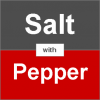 By Pepper Parr By Pepper Parr
October 20th, 2019
BURLINGTON, ON
OPINION
So who is it going to be?
There are three constituencies representing the people of Burlington.
Milton, which covers parts of wards 3 and 6 – the northern part of the city
Oakville North Burlington which cover part of eastern Burlington and part of Oakville.
Burlington is where the bulk of the people in the city will vote
Maps of all three are set out below.
Where is the vote going to go? Some of the best political minds in the country don’t know; what seems to be pretty certain is that we will have a minority government. The Conservatives believe they will form that government – the Liberals are just as certain.
The NDP and the Greens aren’t going to form a government – but one of them will probably hold the balance of power.
Our take on the candidates:
 Sean Weir for the Conservatives in Oakville North Burlington  Karina Gould for Burlington  Lisa Raitt for Milton. Burlington where the candidates are: Karina Gould, the incumbent; Gareth Williams – Green Party; Lenaee Dupuis – NDP; Peoples Party – Peter Smetana and Jane Michael – Conservative.
The Gazette sees Karina Gould as the best choice – although Gareth Williams has done a superb job for the Greens even if he didn’t put in as much time as he should have campaigning. How and why Jane Michael ever got the Conservative nomination has astounded most of the Conservatives we talked to.
The candidates in Milton are: Lisa Raitt – Conservative; Adam van Koeverden – Liberal; Eleanor Hayward – New Democrat; Farina Hassan – Green Party and Percy Dastur – People Party
In Milton, new comer Adam van Koeverden has a chance – we think Lisa Raitt will hold her seat.
The candidates in Oakville North Burlington are: Sean Weir – Conservative; Gilbert J. Jubinville – Peoples Party; Pam Damoff – Liberal; Nicolas Dion – New Democrat and Michael Houghton – Green Party
In Oakville North Burlington Sean Weir could beat Pam Damoff. She hasn’t been that strong a Parliamentarian.
We will learn just how serious people in the Halton Region are about Climate Change when we see what the vote count for the Green Party is – the surge in the New Democrat vote is yet another sign that in
Salt with Pepper is the musings, reflections and opinions of the publisher of the Burlington Gazette, an online newspaper that was formed in 2010 and is a member of the National Newsmedia Council.
 The portion of Burlington that is in the Milton constituency  Oakville North Burlington 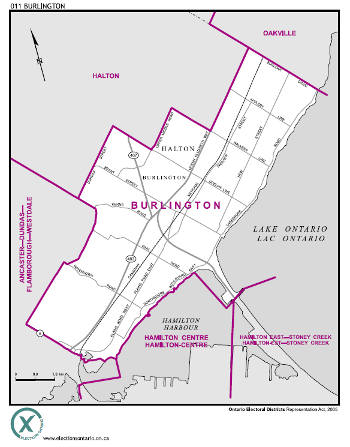 Boundaries for voters in Burlington. 
 By Ray Rivers By Ray Rivers
October 19th, 2019
BURLINGTON, ON
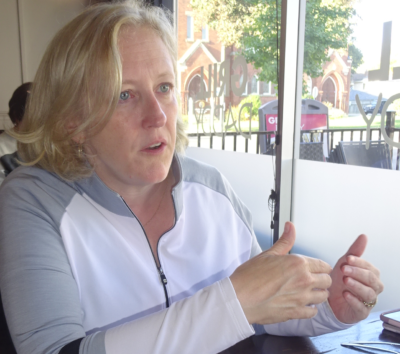 Conservative candidate Lisa Raitt describes the current campaign as the nastiest since Kim Campbell. “Isn’t this the nastiest campaign” I asked, and Milton’s Conservative MP, Lisa Raitt, completed my thought with “since Kim Campbell”?
Andrew Scheer’s campaign started out short on policy but long on name calling and character assassination. He has taken the offensive in every sense of the word, hurling insults like ‘phoney and fraud’, ‘criminal’ and ‘liar’ at the prime minister. And his campaign has been involved in creating and disseminating so much disinformation, it makes the Russian troll factories look like amateurs.
Leaflets falsely claiming Liberals were going to apply capital gains tax on your primary residence. Adverts in the Chinese language media that Trudeau was going to legalize hard drugs. Rumours that Trudeau had been fired from his former teaching job; a} because he’d had an affair with a student; and b} because he had an affair with a student’s mother.
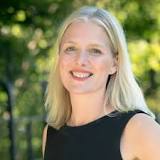 A “Climate Barbie Doll”. Really? Scheer’s campaign manager is Hamish Marshall, a former corporate director and contributor to ‘The Rebel,’ an ultra right-wing medium which has been soft on white supremacist stuff and/or anything sympathetic to the red neck crowd. The Rebel attempted to discredit Canada’s environment minister, labelling her Climate Barbie, until she faced them down for their pathetic attempt at character assassination.
The Conservatives started the campaign saying Trudeau is ‘not as advertised’. Indeed the Aladdin costume stunt did surprise/shock many of us, but older Canadians would have watched Justin grow up as son of one of Canada’s most flamboyant and longest serving prime ministers. We actually know a lot about the Trudeaus. And after four years as prime minister it is hard to understand how ‘not as advertised’ even makes sense.
But Mr. Scheer is that proverbial fella in the glass house throwing stones. He tried to lie about his work experience – neither a broker nor having met accreditation criteria to be one. He tried to conceal his firm position against a woman’s right to choose. He refused to apologize for his earlier anti-LGBT same-sex marriage rants. And he tried to hide his dual nationality, while attacking other party leaders and a former governor-general for theirs. And he must/might have broken US law by crossing the border without using a US passport.
 Regrettable – it did take place 20 years ago when he was a much younger man. But Mr. Trudeau apologized for his ethics violation, for having worn an Aladdin costume and for having mismanaged the SNC prosecution issue. Scheer had never accepted ownership for his past mistakes, has shown no remorse, and appears not to have learned from those experiences. And that just makes him look even nastier.
And it seems to be contagious. Jagmeet Singh has caught the bug. Making things up as he goes along, he has been taking shots at his Green Party opponents, trying to align them with the ‘nasty’ Conservatives. Then as his poll numbers started to climb he turned his attack onto the Liberals, claiming they are in the pockets of the corporate giants, playing the offended sympathy card. His pitch for Pharma care, which all three left-of-centre parties are promising, included erroneous claims that drug prices are rising, when generic drugs have, in fact, fallen over the last decade starting back in the Harper years.
 Elizabeth May scolding the Prime Minister. But unlike Mr. Trudeau, Elizabeth May has strenuously fought back against these false accusations. At the outset, Trudeau had pledged not to campaign on wedge issues, but the Liberals have now started to fight back, though it is probably too late. Mr. Scheer has been effective at tearing down Trudeau’s character – and in this election of personalities that seems to be all that matters. And the debates just made that all the easier.
 Kim Campbell Kim Campbell’s 1993 campaign gets the prize for scraping the bottom of the barrel, and there have probably been other ugly ones before that. It is hard to believe that two seemingly likeable people, Kim Campbell and her campaign manager John Tory, would do such a dastardly thing. But desperation makes us behave in unpredictable ways. So take heart if you don’t think this has been the nastiest campaign yet, there are still a few days to go.
 Ray Rivers writes regularly on both federal and provincial politics, applying his more than 25 years as a federal bureaucrat to his thinking. Rivers was once a candidate for provincial office in Burlington. He was the founder of the Burlington citizen committee on sustainability at a time when climate warming was a hotly debated subject. Ray has a post graduate degree in economics that he earned at the University of Ottawa. Tweet @rayzrivers Ray Rivers writes regularly on both federal and provincial politics, applying his more than 25 years as a federal bureaucrat to his thinking. Rivers was once a candidate for provincial office in Burlington. He was the founder of the Burlington citizen committee on sustainability at a time when climate warming was a hotly debated subject. Ray has a post graduate degree in economics that he earned at the University of Ottawa. Tweet @rayzrivers
Background links;
Kim Campbell – Dirty Campaign – Lies About Drugs –
Conspiracy Theories – Rebel Media – Scheer Campaign –
School Affair Lies – NDP Lies – Scheer US Travel –
Scheer More Lies – Scheer Angry – Not the Nastiest –

 By Ray Rivers By Ray Rivers
October 19th, 2019
BURLINGTON, ON
It was the fall of 1972. I had cast my ballot in Orangeville, where I’d been working as purchasing agent, then hit the road for Ottawa. I’d been offered a better career job with the federal government.
On route one of our vehicles lost its electrical system just outside of Ottawa and we spent the night in a motel watching the election results that night. When the dust had settled I was left wondering whether I would still have a job. The Trudeau Liberals had lost their solid majority and had fallen into the uncertainty of minority government.
 Pierre Trudeau. It had been a tough election. The over-riding issue during Pierre Trudeau’s first term was national unity. Trudeau had ended the immediate threat of separatism by introducing the War Measures Act, eliminating the terrorist organization, the FLQ. But Quebec’s quiet revolution would ensure that the demand for equality in the federation was far from over. So the Liberal government introduced official bilingualism, a concept at least as politically divisive as today’s carbon tax. Though fifty years later there is no longer any debate – it was the right thing to do.
Baby boomers had been pouring into the job market in record numbers, competing for scarce employment with still growing numbers of US draft dodgers arriving across the border. And the economy was recovering from the downturn of the late sixties. New grain markets had been opened up in China. Canadian cultural industries were on the move. Economic growth was projected to exceed by over 6% and the federal budget was close to being balanced. Indeed the land was strong.
So Pierre Trudeau somewhat arrogantly decided to run on his record rather than lay out a new vision for the future. But nobody was reading the fine print and that almost put an end to his vision of the just society. Voters are human after all. They want to know what’s in it for them.
So when Justin decided to run on his record he followed his father’s footsteps and polls show will end up much like his father did, if he is lucky. Andrew Scheer and Jagmeet Singh on the other hand have promised affordability, and suddenly their polls are swelling. Affordability? This is the number one issue for Canadians, more important than protecting our survival and the planet’s climate.
 Justin Trudeau Yet Canada’s economy has never performed better – doesn’t that mean affordability? And this performance is largely the result of policies enacted by the Liberals after 2015, when the nation was teetering on the brink of a recession. Close to a million people, including 300,000 children have been lifted out of poverty, exceeding the government’s own projections and making this the lowest rate of poverty ever in Canada’s history.
Employment is at a record high and unemployment is the lowest since we started recording those numbers. Inflation is at historic low rates as are interest rates, and economic growth is among the best in the G7. Affordability? What else would one expect of a government? Well there is the matter of house prices and the still growing gap between the wealthy and the rest of us.
Housing prices are a function of demand and supply. But there are serious physical limits to increasing supply in our sprawling communities. Only Maxime Bernier’s People’s Party has a viable short term plan – reduce demand, cut off the number of immigrants coming here – the number of people looking for new housing. But his policy is simply dismissed as Donald Trumpian racism. And there may, indeed, be some of that among some of his candidates.
Humanity is almost never satiated, that is both our weakness and our strength. When the times are good as they are now, or as they were when PET arrogantly trotted out ‘The Land is Strong’, those who now have more want to know why they can’t have even more. Pierre Trudeau ended up losing his majority thanks in part to a brilliant campaign by the NDP’s David Lewis and his catchy refrain ‘Corporate Welfare Bums’. Why can’t we have some of theirs?
All of the opposition parties today are claiming to cut corporate welfare, though nobody seriously believes that would happen with the Tories. Even their lower class income tax cut will benefit the wealthy more than the middle class. And aren’t they promising to restore those unfair tax breaks for the business sector? And seriously, have we forgotten Stephen Harper and Doug Ford?
 Jagmeet Singh Jagmeet Singh may be a newbie in federal politics but he is a quick learner. He knows that if you want people on-side you simply tell them what they want to hear. As the third party he knows he won’t have to deliver at the end of the day. And look how Mr. Scheer’s false promises have been working for him. He started his campaign by telling everyone he would put more money in their pockets.
Singh has pulled a page out of David Lewis’ campaign book and is telling people he’ll make their lives better and more affordable by guillotining the heads off the rich and using them to feed the disadvantaged. Steal from the rich and give to the rest of us. Now isn’t that more appealing than just saying ‘The Land is Strong’?
 Ray Rivers writes regularly on both federal and provincial politics, applying his more than 25 years as a federal bureaucrat to his thinking. Rivers was once a candidate for provincial office in Burlington. He was the founder of the Burlington citizen committee on sustainability at a time when climate warming was a hotly debated subject. Ray has a post graduate degree in economics that he earned at the University of Ottawa. Tweet @rayzrivers Ray Rivers writes regularly on both federal and provincial politics, applying his more than 25 years as a federal bureaucrat to his thinking. Rivers was once a candidate for provincial office in Burlington. He was the founder of the Burlington citizen committee on sustainability at a time when climate warming was a hotly debated subject. Ray has a post graduate degree in economics that he earned at the University of Ottawa. Tweet @rayzrivers
Background links:
Comedy or Cringe – !972 Budget –

 By Pepper Parr By Pepper Parr
October 18th, 2019
BURLINGTON, ON
 Did we get it right? A year ago today we all woke up and headed for the polling station during the day and elected ourselves a new city council.
Did we get it right?
Most people appear to think that we did. There are certainly some who think mistakes were made but on balance we have seven people who have a clear vision as to where they want to go.
Next Monday we get to go to the polls again.
Let us try and get it right.
There is a lot of small minded bickering and pettiness being voiced.
Is the dual citizenship that Andrew Scheer has really that big a deal?
Is it what the creation of a government is decided on?
 The people, you and I get to decide who runs that |House of Commons. Think really hard about who you send there to do the job. The Black face was and is a big deal – but it was 20 years ago. Has Justin Trudeau grown up? Has he learned a lesson?
Do we trust him?
That applies to all of them – do you trust them?
There are some very big, fundamental issues before us. If we don’t get them right – we are in serious trouble.
 When this falls apart – we all fall apart. It will not be a pretty picture. There is a tipping point, a point at which we cannot go back.
Are we there yet?
How close to that tipping point are we and do we really want to test it.
If we are wrong – there really isn’t a future.
There is some hard hard thinking to be done.
Salt with Pepper is the musings, reflections and opinions of the publisher of the Burlington Gazette, an online newspaper that was formed in 2010 and is a member of the National Newsmedia Council.

 By Pepper Parr By Pepper Parr
October 15th, 2019
BURLINGTON, ON
On October 9th, the Gazette published an Opinion column by Tom Muir that was based on his attendance at a Local Planning Act Tribunal. A link to that column appears at the bottom of this article.
It was lengthy, which is typical for Muir.
LPAT hearings are not bed time reading.
The readership response to the article was surprisingly strong.
On Saturday, the 12th of October the Gazette received the following from Kwab Ako-Adjei, Senior Manager of Government Relations and Strategic Communications.
 “I wanted to take the opportunity to provide a clarification to a recent article, https://bit.ly/2q5unMg. “I wanted to take the opportunity to provide a clarification to a recent article, https://bit.ly/2q5unMg.
“The article includes a lengthy opinion in which the writer states that City staff had no responses or barely participated in the Local Planning Appeals Tribunal (LPAT) hearing for the proposed development on 92 Plains Road. However, neither the article itself or the opinion make clear that the hearing before the LPAT was a settlement hearing in which the City and the appellant were in agreement on the proposed development and the associated amendments to the City’s planning documents.
“In a settlement hearing, evidence must be provided to the Tribunal to support the settlement. This evidence typically is in the form of the expert opinion of a land use planner from one of the settling parties, as it was in this hearing. The other settling parties, such as the City in this case, do not call further duplicative evidence to support the settlement. It is in hearings where parties such as the City and a developer are not in agreement on the development proposal where the parties call their own witnesses to provide expert opinion, and cross examine opposing witnesses.
“It would be misleading to suggest that because the City did not have its planner provide an expert opinion that she did not act appropriately or that she did not represent the interest of Council’s decision to support the proposed settlement. Rather, the City’s legal counsel made submissions on the appropriateness of the settlement, including in the context of the in-force Official Plan. The LPAT hearing officer will consider the expert evidence provided, along with the submissions of the appellant, the City and the two participants to the hearing, and make a decision in the matter.
“The Notice of Settlement Hearing was also posted on our website, https://www.burlington.ca/en/services-for-you/92-Plains-Road-East.asp so residents could be aware of the hearing.”
We take the view that Opinion pieces are something you candisagree with but that the facts the writer puts forward are not debatable.
We sent the comment from the city to Muir and asked for a response from him. Muir said:
“I don’t know what to say as this just confirms what I said – the City staff Planner said nothing and the Legal staff said not much more and as I stated, which this writer appears to agree with.
“They did and did not do everything I said, and they have what I think are disclosure and professional duties as members of professional associations, that they didn’t act on.
“And the writer missed the part (section 3) of the story that indicated it was a settlement hearing as a part of it.
“The message initially went to MMW and TC and they knew it was a settlement hearing, and item 3 in the piece is as follows –
3. This indicates that the City agreement with the proposed settlement included agreement that the adopted but not legal OP was on the Table and they agreed to let the applicant Planner use it right from the start – they had the evidence from the applicant lawyer and they had to have agreed to it in order to say they had a settlement. The applicant Planner used an anonymous authority to say that someone at City told him this was the City directions anyways so he used it.
 Tom Muir “The City staff said nothing about the misinformation and the frank falsification of parts of the applicant Planners testimony under oath. I raised these points under oath and they know the facts but said nothing, so going along with it.
“And is it professionally appropriate to remain silent about my point 12, (and 10) as follows;
12. In EO 86 the Planner rewrites the statement of the in force OP so as to remove the second of the “shall” policies wording and change it to “is intended to” with respect to maintaining the residential appearance and character of the property.
“This is a frank and deliberate lie to falsify the policy statement wording. City staff said nothing.
“In my view, this blows up the Planners credibility and trust. I would also cite my point 10 above.
“Does this mean that “expert witnesses” can say anything they want? And the City staff bears no responsibility for untruths that they are frank and legal partners to? The writer says the City agrees and does not bring duplicative evidence to support the settlement. Therefore, they agree with it all.
“The City Planner is not an expert witness as the writer implies and this is my experience that I can document but is beyond this space.
“After the Hearing, I wrote her asking for information on my points 10 and 11 and I’m still waiting for a response. There are other requests from me that have also remained un-responded to.
“I stand by what I wrote, and caution the writer that I have a great deal more that I can say on this.
“This story was a short form briefing for the recipients.”
Muir was not told who sent the concern about the Opinion piece he wrote nor was he contacted by anyone from city hall about his opinion. He has said he is still waiting for responses from the Planning department.
We asked a number of other people we respect for their take on note from Kwab Ako-Adjei.
“Something doesn’t make sense here” was one response. “If the City wants to correct something that they feel needs correcting why didn’t they simply ask you for Tom ‘s contact information.”
The writer who insisted that their name not be used added: “Whatever your decide I would suggest you keep at arms length. Don’t put your name to anything in print. City’s Opinion Piece not The Gazettes or Pepper Parr’s opinion piece- with “none of your salt or pepper.”
“I still wonder what is motivating this? Why the need for this public exoneration? Who are they chastising The Gazette or Tom Muir?
Link to the Muir piece:

 By Pepper Parr By Pepper Parr
October 15th, 2019
BURLINGTON, ON
Things to keep in mind as you think about where you want your ballot to go on Monday.
Worth noting is that the number of people who voted in the advance polls increased by 25% over the last election. Some clearly wanted to register their vote.
Will the numbers for 2019 exceed the vote count in 2015?
The issues are pretty clear.
 Prime Minister Trudeau debating Leader of the Opposition Andrew Scheer – it got nasty at times. What I find myself thinking about is the debate behaviour and the spending promises.
These are all educated people who can read without moving their lips. Their parents surely taught them some manners.
The public wants to hear what they say; we want to hear sound, solid, supportable, cogent arguments. We didn’t get much of that.
Could the moderators not have threatened to cut off the microphones of those who talked over another speaker? There were a few occasions when one of the female moderators clamped down on a speaker. It needed to happen more often.
 Yves-François Blanchet leader of the BLOC debates Jagmeet Singh, leader of the New Democrats. The people who moderate have a responsibility to first set out the rules, warn what will happen when a rule is broken and then enforce the rules.
Can you imagine the behaviour change if a moderator turned off the microphone of a speaker who kept butting in on another speaker’s time?
 Green Party leader Elizabeth May goes after Prime Minister Justin Trudeau during an English language debate. The public deserves better, the process deserves better. Demand better.
Now – the spending. These people are asking to be THE leader of the country while they throw your money around like confetti at a wedding and give the public quickie accountings as to just how they are going to pay for those promises.
This is irresponsibility at a dangerous social level. The politicians give us what they think we want to hear – we applaud them, elect them and then complain bitterly when they fail to deliver on those ‘promises’.
There are lessons here for both the elected and the electorate.

 By Ray Rivers By Ray Rivers
October 14th, 2019
BURLINGTON, ON
Canada is one of the world’s leading contributors to climate change. Here are some facts:
 Canada’s climate is warming at twice the rate of the rest of the world. 1. Canada is the 38th most populated nation on earth and we have the 11th largest economy;
2. But we are also the seventh (7th) biggest global emitter of climate changing greenhouse gases (GHG);
3. Each Canadian produces 22 tonnes of GHG per year, the highest among all G20 members and nearly three times the G20 average of eight tonnes per person;
4. Canada’s climate is warming at twice the rate of the rest of the world; and
5. The UN says we have twelve years – three election terms – to make major reductions before we reach a point of no return for our climate.
As Canadians go the polls all of the political parties but two are committed to significant GHG emissions reductions. Only the Conservatives and the Peoples Party have platforms which will allow emissions to continue to increase, virtually unabated. And given that Andrew Scheer’s Conservatives are either leading or tied with both in popular support and the potential seat count, this should be a serious concern for Canadians everywhere.
 Andrew Scheer and Doug Ford: Is this a scene we are likely to see repeated? A Conservative party election would negate all of the current government’s recent initiatives on climate action, much as Ontario saw happen with the Ford government. Ford reset, lowered, provincial emissions targets after taking office, but has failed to make progress even on these. And unsurprisingly Mr. Scheer’s climate program mostly parallel’s Ford’s, including ending carbon pricing.
Elizabeth May’s Green Party has the most ambitious plan to reduce emissions, virtually doubling Canada’s committed reductions to the Paris climate plan – 60% by 2030. Unfortunately her plan is probably not realizable, at least not without a major buy-in by all Canadians. Her plans include banning the sale of gasoline powered cars by 2030. That would be fully a decade ahead of a similar law in B.C. and would necessitate the availability of over two million new electric vehicles for sale by 2031.
Sounds crazy, I know. But that is why the carbon tax makes so much sense. The tax increases annually as the availability of emission free vehicles and charging facilities become available. The existence of an ever increasing carbon price sends a powerful market signal to both buyers and vehicle manufacturers – shift to non carbon alternatives. And if you use an alternate you are rewarded by the rebates.
 William Nordhaus Sterling Professor of Economics at Yale University and the world’s leading economist on climate change, has been awarded the 2018 Sveriges Riksbank Prize in Economic Sciences for “integrating climate change into long-run macroeconomic analysis. Short of sending people to jail, market place mechanisms are the most effective way of changing behaviour and in this case, getting people out of their gas guzzlers. But don’t take my word for it, check with just about every environmental economist out there, including the guy who won a Nobel prize recently for exactly that thesis.
What is it that so-called business friendly Tories like Ford, Kenny and Scheer don’t get?
But May also wants to shut down oil production and the TMX (Trans Mountain pipeline) expansion. She’d start her attack on the oil polluters by cutting the subsidies. But she isn’t nuts, or as extreme, as some might think. Even Mr. Harper, back in 2015, joined other G7 leaders in calling for an end to fossil fuel usage by 2100. Ms. May just wants to speed that up… a lot . And for someone who has spent her entire life working for the environment she should know what she is taking about.
After all, if we only have twelve years until the big turning point when global warming becomes irreversible and takes on a life of its own, 2100 is at least 70 years too late. Mr. Trudeau is calling for Canada to be carbon neutral by 2050. But even that is too late, given what the climate scientists are saying.
Mr. Scheer, with his support base largely in western Canada likely gets his science from the oil companies, though many of those also support carbon pricing and movement to cleaner energy production. But he still thinks he can build more pipelines and expand the oil sands. And to add insult to injury he is also planning to cancel an EV purchase incentive program.
 The world as we need to at least begin to see it. Even though Mr. Scheer has no plan to eliminate the deficit during the next government cycle, he still speaks to it as if he did. And everyone can agree that we don’t want to saddle future generations with massive financial debt. But none of that will matter once we upset the earth’s climate such that the global support systems are badly damaged and we can only bequeath a sick planet to our children and theirs.
 Ray Rivers writes regularly on both federal and provincial politics, applying his more than 25 years as a federal bureaucrat to his thinking. Rivers was once a candidate for provincial office in Burlington. He was the founder of the Burlington citizen committee on sustainability at a time when climate warming was a hotly debated subject. Ray has a post graduate degree in economics that he earned at the University of Ottawa. Tweet @rayzrivers Ray Rivers writes regularly on both federal and provincial politics, applying his more than 25 years as a federal bureaucrat to his thinking. Rivers was once a candidate for provincial office in Burlington. He was the founder of the Burlington citizen committee on sustainability at a time when climate warming was a hotly debated subject. Ray has a post graduate degree in economics that he earned at the University of Ottawa. Tweet @rayzrivers
Background links:
Canada Produces Most GHG –
Most Powerful Tool –
Ford Does Nothing on Climate –
Harper G7 End of Fossils –
Dirty Oil –
The Polluters –

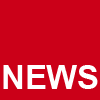 By Pepper Parr By Pepper Parr
October 9th, 2019
BURLINGTON, ON
The Gazette received the following from the city three days afrer the article appeared.
“I wanted to take the opportunity to provide a clarification to a recent article, https://bit.ly/2q5unMg.
“The article includes a lengthy opinion in which the writer states that City staff had no responses or barely participated in the Local Planning Appeals Tribunal (LPAT) hearing for the proposed development on 92 Plains Road. However, neither the article itself or the opinion make clear that the hearing before the LPAT was a settlement hearing in which the City and the appellant were in agreement on the proposed development and the associated amendments to the City’s planning documents.
“In a settlement hearing, evidence must be provided to the Tribunal to support the settlement. This evidence typically is in the form of the expert opinion of a land use planner from one of the settling parties, as it was in this hearing. The other settling parties, such as the City in this case, do not call further duplicative evidence to support the settlement. It is in hearings where parties such as the City and a developer are not in agreement on the development proposal where the parties call their own witnesses to provide expert opinion, and cross examine opposing witnesses.
“It would be misleading to suggest that because the City did not have its planner provide an expert opinion that she did not act appropriately or that she did not represent the interest of Council’s decision to support the proposed settlement. Rather, the City’s legal counsel made submissions on the appropriateness of the settlement, including in the context of the in-force Official Plan. The LPAT hearing officer will consider the expert evidence provided, along with the submissions of the appellant, the City and the two participants to the hearing, and make a decision in the matter.
“The Notice of Settlement Hearing was also posted on our website, https://www.burlington.ca/en/services-for-you/92-Plains-Road-East.asp so residents could be aware of the hearing.”
If you have heard of LPAT; know what the acronym stands for – read on.
If you don’t – quit now.
LPAT is Local Planning Appeals Tribunal.
It is the level the developers and city can turn to when there is a difference over a development proposal.
Few of the people who follow this stuff have much that is positive to say about the tribunal.
A handful of people chose to sit in on an LPAT hearing at city hall recently.
Tom Muir, one of the types that keeps up to date on this stuff attended – here is what he had to say on what he saw and heard,
I want to provide you with a short briefing on my experience. I have provided you with extended notes and comments on this appeal evidence so I will stick to key points and, as it turned out, a long one page of 13 points.
1. The Lawyer representing the City, David Klacko, and the City Planner, Melissa Morgan, indicated to the LPAT Chair that they would not be presenting any testimony or evidence. Over all, from my perspective over the entire Hearing they might as well have not been there.
 Architectural rendering 2. The Applicant lawyer and Planner disturbed me when they went straight to the adopted Official Plan as the first argument in the Policy Frame supporting the proposal (Item 12 of 112 in the Evidence Outline).
I was further disturbed when the City Lawyer and Planner said nothing at this time about this and as supposed professionals with obligations of disclosure, did not indicate that this adopted OP was not in the City Policy Frame for policy and thinking in this application.
It was only at the very end of the Hearing after all the testimony was done, did the City lawyer say about 20 words to indicate that the adopted OP was not in the City policy frame here, but that the proposal conformed with the in force OP.
3. This indicates that the City agreement with the proposed settlement included agreement that the adopted but not legal OP was on the Table and they agreed to let the applicant Planner use it right from the start – they had the evidence from the applicant lawyer and they had to have agreed to it in order to say they had a settlement. The applicant Planner used an anonymous authority to say that someone at City told him this was the City directions anyways so he used it.
4. This applicant Planner stated that the amendments requested conform with the general policy directions of the new draft Burlington Official Plan (EO 107). He also stated that this adopted OP conforms to the Halton Region Official Plan when this is patently false as the Region did not approve it on the grounds of non-conformity. The applicant lawyer tried to argue that the adopted OP is legal and can be used.
5. Overall, in this Planner testimony, there was a great deal of emphasis on the adopted OP in support of the application and settlement. In this testimony, given under oath, there was a total disregard and no mention for the “shall” or mandatory OP and Zoning policies specific to this site. City staff made no comments. There was no explanation or planning rationale provided for disregarding the “shall” provisions. City staff said nothing.
6. I was given 20 minutes to testify under oath and I raised a large number of issues from this previous testimony and from my own evidence. I will provide only a few of the key issues here. The City Lawyer did not cross examine my testimony.
6. There was applicant Planner disregard to compatibility policies with only 1 criteria mentioned (upper floor setbacks) out of the City policy number of 13. City staff said nothing.
7. Nothing was said or evidence provided about the City policies on intensification adjacent to existing low density neighborhoods. City staff said nothing.
8. There was no evidence or testimony about the City Policies around Urban Design and City Guidelines for Mixed Use and Residential Mid-Rise Buildings. City staff said nothing.
9. These policies are indicated by the City as policies subject to “shall” be done for all proposals. Nothing was said or done by either Party on these.
 Site rendering. 10 The applicant Planner misleadingly wrote in EO item 10 (Subject; Surrounding Land Uses), and further stated under oath, that a “property at 105 Plains Rd received approval in 2013 for demolition (done) in order to construct a mixed use building, however, building permits for the mixed use building have not yet been issued. In addition, in oral, he stated that an 11 storey building was planned. This was not only misleading and untrue, but there is no such application in the City files.These statements were presented as I noted, as a surrounding land use and were taken by the Chair as a factual support for the 92 Plains proposal.
City staff said nothing to factually clarify the truth of the matter. I wrote the Planner yesterday asking for this information, which she should have, but I have not heard anything back.
11. The applicant Planner repeatedly (10 times; EO 11, 39, 54, 56, 62, 67, 72, 83, 99, 111i) and incorrectly stated, that the proposal at 92 Plains Rd was within 500 meters of the Go Train station, which is a MTSA, and therefore the site is in the Mobility Hub area having a 150 unit/ha target. He used this to repeatedly argue support for the proposal and this is misinformation used in a misleading way repeatedly.
This estimate of distance is important because of the MTSA target boundary, so I had two different distance estimates to dispute this in testimony. The first is an estimate from Google of 600 meters straight line, and a second is by car from parallel to the Go station building estimated straight down Waterdown Road to Plains RD corner light, which is about 650 meters. Note that these are straight line distances and nothing moves to the GO in a straight line from the site on 92 Plains Rd.
City staff said nothing to clarify.
12. In EO 86 the Planner rewrites the statement of the in force OP so as to remove the second of the “shall” policies wording and change it to “is intended to” with respect to maintaining the residential appearance and character of the property.
This is a frank and deliberate lie to falsify the policy statement wording. City staff said nothing.
In my view, this blows up the Planners credibility and trust. I would also cite my point 10 above.
13. In the written and spoken under oath testimony the applicant Planner committed a significant number of omissions of relevant evidence, states partial evidence resulting in misinformation, untruths such as above, fallacies such as non sequitors, false dilemmas, begging the question or circular arguments that have the conclusion wanted based in the premises, and others beyond this space.
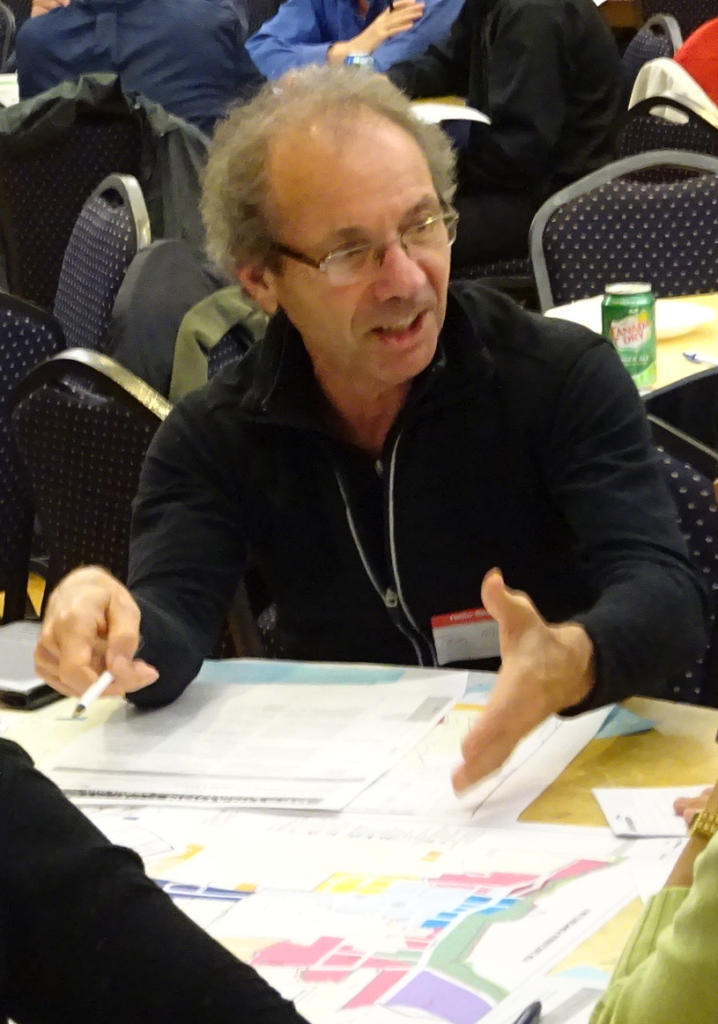 Tom Muir making a point at a community meeting. I have written more here than I expected and there are many more points I could cover. I will also say that the City staff, and the applicant Planner, having professional and disclosure duties associated with the law and planning professions and oaths of office, could have helped me and the Hearing and Chair, with getting to the truth and the facts, but they chose to remain silent and not assist in this.
What was clearly wanted, and certainly delivered, was a set of OP and Zoning amendments that is custom made to fit the settlement proposal. What the real plan or truth is has nothing to do with it.
In conclusion, I will say again that this settlement will have implications and consequences as a precedent setting model for what is to be willingly enabled, permitted and allowed in Burlington. It will be carried into whatever size you want to think of everywhere.
This is where your new Plan is going. “Ye who enters here, abandon all hope.”
Tom Muir is an Aldershot resident who knows more about Development Charges and far more than anyone should know about development in the western end of the city.

 By Pepper Parr By Pepper Parr
October 9th, 2019
BURLINGTON, ON
Figure this one out.
There is a development proposed for some of the property on the land between Lakeshore Road and Old Lakeshore Road – referred to as the “football”
 The first of two 24+ storey structures planned for the “football”. The development is controversial.
The city sent out a notice with the following note:
updated supporting documents
Application received – September 13, 2019
Then there is a list of the supporting documents.
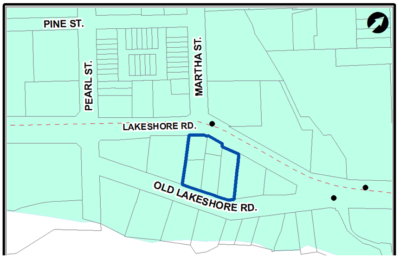 The property to the right of the CORE development (outlined in blue) also has a 24+ development proposal, • Arborist Report
• Architectural Plans
• Construction Management Plan
• Construction Management Plan 2
• Construction Management Plan 3
• Environmental Site Screening Checklist
• Functional Servicing and Stormwater Management Report
• Geotechnical Investigation
• Grading and Site Servicing
• Heritage Impact Statement
• Landscape Concept Plan
• Noise Impact Study
• Pedestrian Wind Study
• Phase I ESA
• Phase II ESA
• Planning Justification Report
• Reliance Letter
• Remediation Plan
• 7th Floor Amenity Plan
• Shoring and Excavation Plan
• Site Plan
• Sun Shadow Analysis
• Survey
• Transportation Impact Study
• Urban Design Brief
• Waste Management Plan
No mention of which document was updated or what part of the document was revised.
The Planner on the file, Melisa Morgan, will know what and where the updates are – could she not have shared this information?
This sort of thing happens again and again – and is accompanied by that bit of tripe that talks about an engaged city.
Related news stories:
CORE public presentation
Old Lakeshore Burlington Inc. development.
There are other options.
Salt with Pepper is the musings, reflections and opinions of the publisher of the Burlington Gazette, an online newspaper that was formed in 2010 and is a member of the National Newsmedia Council.

 By Ray Rivers By Ray Rivers
October 8th, 2019
BURLINGTON, ON
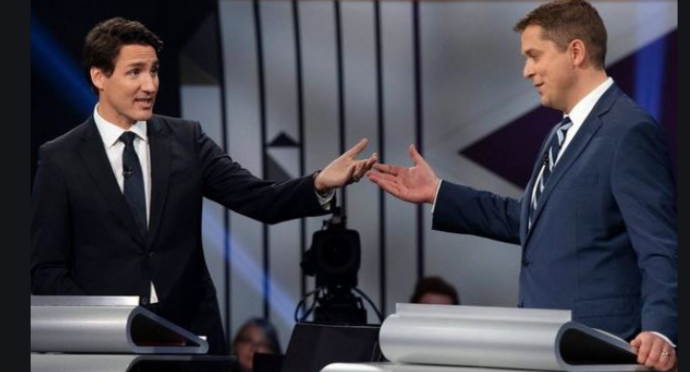 Just Trudeau and Andrew Scheer – they hammered away at each other. Neither managed to land a really hard punch. There were fleeting discussions around some issues, but all anyone will remember is the storm of insults hurled by adults acting like children.
And it all started with Andrew Scheer using his opening speech to level insults, and stunning hyperbole, at the prime minister.
“He puts on a middle-class mask and then raises taxes on middle-class Canadians. Mr. Trudeau you are a phony and you are a fraud and you do not deserve to govern this country….”
The concept of a single national leaders forum to discuss policy in both official languages is a worthy goal. But the proof is in the execution and there was so much wrong with this so-called debate. There was way too much on the program plate to being with. And when one tries to do everything one seldom does anything well.
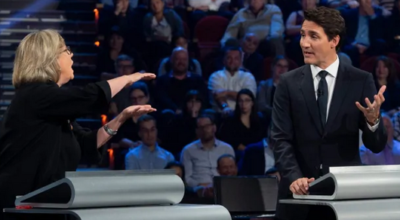 Elizabeth May, Green Party leader held her own – was it enough to advance their number of members in the House. For another thing there is no such thing as an ordinary undecided Canadian voter. And I’m getting really tired of seeing some random uninformed person pretending to represent me and asking a poorly constructed question to the leaders. That time would have been better utilized in the debate proper by the party leaders to actually explain their policies.
Then there were too many people involved for an effective debate. And while everyone wanted to be there, not everyone benefitted from that experience. Maxime Bernier, for example, might have stood a better chance of winning, at least his own seat, had he just stayed home. And what is a separatist party doing in a debate about national issues?
While the Greens, NDP, Bloc and the People’s Party all serve a useful function in our political system by bringing ideas to the table, there is no hope any of them will be forming government.
 Maxine Bernier on the left Yves-François Blanchet of the BLOC, center and Jagmeet Singh – they won’t form a government but they could determine who does govern. And how is it fair that a party without official party status, and currently holding only a couple seats, like the Greens, Peoples or BLOC, get equal debate time with the Liberals or CPC which hold the vast majority of seats and popular support? Shouldn’t they have just mailed in their questions instead?
But it was the negativity which almost sent me off to bed for an early night. Real debates are supposed to be beyond insults and slander. And Scheer wasn’t the only one trying to brand his main opponent, though he was the worst. That is after all, the sum total of how the Conservatives are running their campaign this year. Almost half of everything (47%) coming out of mouths of the Conservative Party of Canada (CPC) is negative and personal, and all of it aimed at Mr. Trudeau. And, despite Mr. Singh claiming the high moral ground, the NDP is almost as bad.
Oh sure, negative campaigns work. At least they did in the USA for Donald Trump, who falsely accused his opponent of being crooked, accompanied by a charming chant of ‘lock her up’. It was a lie but if you repeat a lie often enough people start to believe it. And though Trump lives in a glass house, none of the stones have ever bounced back to hit him – at least not yet.
And so it is with Mr. Scheer. He lied on his resume about being an insurance broker. He tried to hide his dual nationality. Doesn’t he break US law every time he crosses the border without his US passport? And he lies every time he talks about the federal carbon tax.
 Andrew Scheer – he was better in the English language debate – French is not a language he is comfortable with. Scheer has never taken responsibility for his actions. Unlike Trudeau who recognizes his mistakes, Scheer never apologized for misleading people with his fake resume, not his previous stand on LGBT rights, nor holding back on his citizenship. And how ironic to label Trudeau with ‘not as advertised’ and ‘can’t be trusted’.
There are serious policy differences between the two leading political entities in this country. Let’s have a serious debate about the future of fossil fuels and whether we need more pipelines and petroleum resource development.
Let’s discuss the merits of doing more of what we have always done or taking more drastic climate action. Let us address the still growing wealth and income gaps in this country. Let us resolve the importance of balancing the budget versus borrowing for investment in our human and physical capital, and growing the economy.
Maxime Bernier has invited Canadians to have an adult discussion on immigration and our refugee policy. Elizabeth May has demanded that we ban the internal combustion engine by 2030. Jagmeet Singh would like Canada to reopen the constitution and find a new accommodation for Quebec.
Mr. Scheer has promised to bring back a partisan Senate and Mr. Singh’s party has long called for its abolition.
What about defence policy and Canada’s contribution as it applies to NATO spending targets? There is discussion of a wealth tax and of raising the capital gains tax to 100%. What about China?
This week’s debate may have been good entertainment, though for me it was depressing. Government should be about policy and not just theatre. It is unclear if any one of the six party leaders ‘won’ in the so-called debate, but we all lost an opportunity to be better informed on the issues before us and what these characters would really do if we elect them PM.
 Ray Rivers writes regularly on both federal and provincial politics, applying his more than 25 years as a federal bureaucrat to his thinking. Rivers was once a candidate for provincial office in Burlington. He was the founder of the Burlington citizen committee on sustainability at a time when climate warming was a hotly debated subject. Ray has a post graduate degree in economics that he earned at the University of Ottawa. Tweet @rayzrivers Ray Rivers writes regularly on both federal and provincial politics, applying his more than 25 years as a federal bureaucrat to his thinking. Rivers was once a candidate for provincial office in Burlington. He was the founder of the Burlington citizen committee on sustainability at a time when climate warming was a hotly debated subject. Ray has a post graduate degree in economics that he earned at the University of Ottawa. Tweet @rayzrivers
Background links:
Five key moments
Two two mainline parties.
Where do they stand on taxes

 By Pepper Parr By Pepper Parr
October 7th, 2019
BURLINGTON, ON
The Marsdens (Dave and Anne) were never in the business of making life easy for their elected officials.
It has cost them dearly. They have been treated with contempt, not permitted to talk to city staff and then barred from city hall as well as barred from Regional Council.
They are prickly.
 Anne and David Marsden – delegating at city council. They are now permitted to delegate at city hall; they appeared during the Provincial Review earlier this year at the Region.
This morning they were at the podium in Council Chambers pointing out an embarrassing situation.
The Agenda for the meeting this week had several problematic entries.
Several of the important items did not have a report attached which meant that anyone who wanted to know what the Agenda item was about was basically out of luck. All they had was a headline.
The Marsdens don’t take to that kind of behaviour and they stood at the podium and asked, first; why there were no reports attached to the Agenda item, and because one was of particular interest to them they wanted any discussion to be deferred to the November round of Standing Committee.
At one point it got rather testy when Ms Marsden made a statement that the chair wanted her to strike from the comments she had made.
That didn’t go down all that well with the Marsdens.
The issues for the Marsdens was that in order to delegate on a matter you had to register with the Clerk’s Office not later than the Friday before the scheduled meeting.
The following agenda items had no report attached to them.
Infrastructure Funding CM 22-18
Note: This item will be distributed under separate cover.
City Wide Private Tree bylaw Implementation RPF 15-19
Note: This item will be distributed under separate cover.
2020 Calendar of meetings for Council and Standing Committees. CL 16-19
Note: This item will be distributed under separate cover.
The private tree bylaw issue was extremely divisive; there were a lot of harsh words said at several of the meetings. How city hall thought they could actually get away with something like this is astounding.
Not sure which is worse – that it was deliberate or a stupid administrative error.
Without knowing much about the report that was going to be debated – the Marsdens didn’t feel they could delegate. They did manage to scoot down to city hall late on the Friday and get a copy of the report – which when they saw the details they were very certain that they would be delegating.
How do things like this happen? Who lets an Agenda like this get sent out? The city Clerk is responsible for the Agenda – but the city manager signs off on everything.
 Is there something about his building that prevents the left hands of those who work there from knowing what the right hand is doing? There wasn’t much in the way of an explanation – other than a media release sent out by the city later in the day saying they were “Making it easier for residents to find information about development applications, construction and road restrictions.”
On a separate matter Heather MacDonald, Executive Director of Community Planning, Regulation and Mobility said: “We understand that at any given time, there can be a lot of activity happening in the city and it’s not always easy to know where to go to learn more information.”
Something isn’t right here.

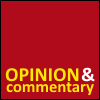 Blair Smith and Lynn Crosby Blair Smith and Lynn Crosby
October 7th, 2019
BURLINGTON, ON
“If you judge from appearances here,’ replied Madame de Chartres, ‘you will be often mistaken; what appears is seldom the truth.”
― Madame de La Fayette, The Princesse de Clèves
Or to paraphrase in modern idiom, “what you see may not be what you get.” Appearances are deceptive, particularly when there is an intent to mask what is planned.
For months now WeLoveBurlington has been warning the citizens of Burlington and Halton of the potential dangers of regional government amalgamation. We have talked about the possible MegaCity of Halton, the flawed process of the regional government review, the history of the reviewers, the comforting ‘party line’ assurances of our elected representatives and the broken consultation record of our current provincial government.
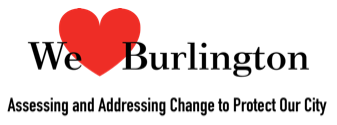 We have attempted to be fair, accurate and non-partisan. We have posted links to numerous articles, several by noted conservative analysts, that all have a common message – municipal amalgamation is seldom successful. Most frequently, it results in higher taxes, greater municipal debt, reduced services, increased cost of government and loss of local voice. We have attempted to be fair, accurate and non-partisan. We have posted links to numerous articles, several by noted conservative analysts, that all have a common message – municipal amalgamation is seldom successful. Most frequently, it results in higher taxes, greater municipal debt, reduced services, increased cost of government and loss of local voice.
One of our Burlington MPPs has claimed categorically that there will be no amalgamation of any of the municipalities in Halton; another Oakville MPP has cited MegaCity warnings as “false and misleading”. So, where does the truth fall? Let’s examine one possibility – that external appearances may remain much the same but the truth will be a dramatically restructured region under the covers.
Once “the report” is made public in late Fall/early Winter – and we see no reason why it shouldn’t be – what might it contain? Here is one of many possible scenarios. Perhaps the review will leave the existing Halton Council structures much the same – both in name and in number. Burlington, Oakville, Milton and Halton Hills will remain with their existing contingent of councilors and mayors. They will continue to hold meetings, set budgets (within certain parameters) and develop plans responding to constituent needs and operational priorities.
 Is this a case of – what you see is what you get – or are appearances really deceiving? In other words, the local identity will still be the local identity – at least in appearance. But will the program, policy and operational frameworks be the same? Suppose that instead of ‘amalgamation’ we have ‘consolidation’ using a model that is quite common and in extensive use within the provincial government; that of the “cluster” or centre-satellite.
Within this scenario policy, program development and administrative control are exercised at the “centre”; local service operations by the ‘municipality’. So, it is likely that all remaining emergency services (health, fire and police in total) will be consolidated at the regional level. So too will transit have a regional scope rather than local presence with much tighter integration with integrated ticketing (Presto farecard) and centralized scheduling/operations. Purchasing would be done regionally, using developed vendors-of-record or accessing provincial agreements and local fleet management would be a thing of the past.
Could there be economies of scale and efficiencies realized? Possibly, if done well but the increase in the regional bureaucracy will be extensive and the local municipalities will likely maintain much the same staffing. There will also be local Information technology, legal, finance, human resource and Clerk functions but they will report to senior portfolio executives on the Regional level and it will be the latter, sitting as an Executive Committee, who will set policy frameworks, strategic directions and operational program components. In fairness, there could still be benefits achieved that might mitigate the remove of local service provision to a more distant governance structure.
However, it becomes increasingly more problematic as more and more functions, thus power and control, are vested in the regional centre with probable loss of sensitivity to local service issues and environment.
The death knell of local voice, local expression and local direction would be the regional consolidation of municipal land planning, development and management functions. This is the prize that, arguably, is the animus behind the whole review exercise; the jewel teasingly revealed by tentative provincial forays into the protected green-belt and then openly burnished by Bill 108.
WeLoveBurlington has, from the onset, stressed the interconnection between the regional governance review, Bill 108 and the proposed restructuring of land development mediation/arbitration functions – from OMB to LPAT to RPAT?? Indeed, for at least eight years, Burlington has been caught in the vise-grip of provincial intensification targets, bureaucratic indifference, private sector self-interest and an arrogant, entitled Council. Much of the damage has unfortunately been done and is beyond recall but the people’s voice – clearly heard last October 22nd – needs to resonate again and loudly.
Is this outcome conjecture? Yes, but it’s also a reasoned and very possible direction. It would leave only the shell of local authority to mask a consolidated, centralized and distanced governance at the region, a MegaCity in everything but name. Whether ultimately fantasy or foresight, WeLoveBurlington will provide an unbiased and balanced assessment of the change. Even if it walks like a duck and quacks like a duck, we’ll still let citizens know if they’ve actually been given a turkey.
Question for Burlington Federal Candidates
We have submitted the following question to the candidates representing Burlington in the upcoming federal election. We will post any replies that we receive.
Recognizing that municipalities are the creatures of the provincial government and almost totally under provincial control, what could you do, as Burlington’s federal government representative, to ensure that the City retains a strong identity with a resonant local voice?
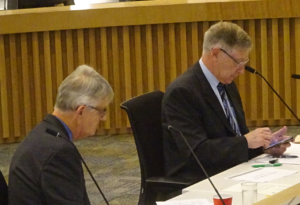 Michael Fenn and Robert Seiling did the Provincial Review; Fenn was once the city manager of Burlington. Regional Review Report Received by Minister
The CBC reported last week that the regional review report has been in Minister Steve Clark’s hands since September 20.
The article states: “Clark said he would take his time with the report before he presents the findings to his cabinet colleagues as “confidential advice” and before deciding whether to make the details public.
Related news stories.
Provincial Review: The issue
What the Lovelies had to say.

 By Ray Rivers By Ray Rivers
October 3rd, 2019
BURLINGTON, ON
The Bloc leader, Yves-François Blanchet, was in good form, making his points as the leader of the resurgent Quebec federal, but separatist, party. It has to be an appealing option for Quebecers – a political party dedicated solely to protecting their interests in Parliament. And their end goal is ‘Quebexit’ (Quebec exit). After all, as Mr. Scheer pointed out, thanks to Mr. Harper Quebec already can claim ‘nation’ status.
 Five candidates took part in a French language debate: Yves-François Blanchet, for the BLOC Quebec, Andrew Sheer for the Conservatives, journalist Pierre Bruneau, Justin Trudeau for the Liberals and Jagmeet Singh for the New Democrats. Justin Trudeau was reserved, calm and collected even when when he was bombarded by personal attacks and cut off in mid-sentence by both Singh and Scheer. He chose to patiently bide his time even if it did reduce his speaking time. And he chose to ignore cheap shots by Sheer over costumes, his passion for canoeing or about about having two planes, which he also used during the 2015 election. Indeed, unlike Scheer, he did buy emission credits for his travel.
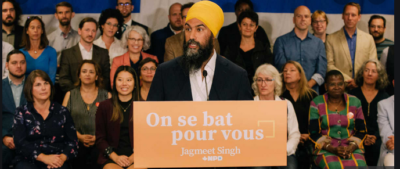 Jagmeet Singh with some of his supporters. Jagmeet Singh spoke well, at least until he started into his well-worn rant about the rich and poor. In the process he took personal shots at Trudeau, calling him rich. In fact Justin inherited a little over a million dollars when his father died – about the value of a nice bungalow in Toronto. And it’s not as if Singh, a lawyer, was ever poor. His father, a successful psychiatrist, put him through a private American high school which charges US $31,260 annual tuition. He is known to wear tailor-made expensive suits, owns a couple of Rolex watches and chooses to ride a high end bicycle.
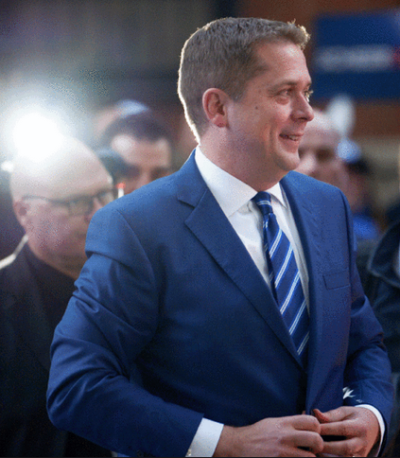 Andrew Scheer, leader of the Conservative Party. Almost every time Trudeau was given the podium, Andrew Scheer would butt in to interrupt him in broken French. And it was painful watching Scheer stumble with a language he never will be able to speak fluently. While Scheer’s French comprehension seemed pretty good, his ability to express himself was abysmal. For someone who grew up in mostly bilingual Ottawa, attended French immersion classes, and would have had free language training as an MP, that is inexcusable.
Scheer has been a federal MP for 15 years, since 2004, and House speaker from 2011 till 2015. Watching him stumble on the podium was embarrassing for everyone. Finally Mr. Blanchet helped him out by translating his so-called win-win strategy as just an ‘oil pipeline’. And even Singh got frustrated as Scheer fumbled trying to translate the Anglicism win-win into French.
But language aside it was what he was saying that differentiated him from the other candidates/party leaders. When Trudeau asked him directly, he refused to endorse a woman’s right to choose. Though the next day he said he is pro-life, what ever that means. We are all pro-life, but he is anti-choice.
His climate change dream plan amounts to a bunch of hypothetical schemes and a recycled home energy retro-fit program. And his plan to cancel the carbon tax seemed so out of context, especially given his refusal to acknowledge the carbon tax-rebate. Scheer re-iterated the false-hood that a carbon tax doesn’t work.
But where he really ran into trouble was his big win-win job creation project – an oil pipeline across Quebec. That is never going to fly in today’s Quebec. They understand that the gasoline car is on the way out, to be replaced by the EV In fact, if Scheer had checked he would have found out that Quebecers buy more EV’s per capita than folks anywhere else in the country.
 Prime Minister Justin Trudeau seeking a second term of office. Inevitably Trudeau was also challenged for his government’s apparent hypocrisy in purchasing the TMX pipeline and his plans to more than double capacity. Perhaps explaining that he was using federal money to protect Alberta’s oil industry would have been unwise, given where he was speaking? Instead he defended the purchase on the basis that profits from the pipeline will be dedicated to fund national renewable energy projects.
TVA, the French language network hosting the debate, has broad coverage through out Quebec, particularly in the area outside of Montreal. This is territory traditionally friendly to the Conservatives. So it was important for the Tories to hang onto their ridings here. But this was also an opportunity for the Bloc, NDP and Liberals to try to take some of these ridings away.
And the truth is that Mr.Scheer had a really bad night. It was the toxic combination of what he said as well as how he said it. Scheer’s main platform is about a national energy corridor which includes an oil pipeline. There is no social acceptability for that kind of initiative in this province. Quebecers care deeply about climate change and the environment so the last thing they want is another oil pipeline.
 Yves-François Blanchet, leader of the BLOC. was clearly the winner There is another French language debate, so one shouldn’t count Mr. Scheer out of the race just yet. Berlitz can work miracles they say. But, language aside, he has his work cut out on policy development if he wants to inch his way into the hearts of Quebecers.
Blanchet was clearly a winner and Trudeau held his own. Singh performed well, but it remains to be seen whether Quebecers will opt for retaining the remaining NDP seats in the face of a mostly like-minded Bloc that is committed solely to their provincial interests. And for a land which recently enacted a law outlawing public servants wearing religious symbols, Mr. Singh has a huge uphill climb to convince them that he should be the top public servant of the country.
 Ray Rivers writes regularly on both federal and provincial politics, applying his more than 25 years as a federal bureaucrat to his thinking. Rivers was once a candidate for provincial office in Burlington. He was the founder of the Burlington citizen committee on sustainability at a time when climate warming was a hotly debated subject. Ray has a post graduate degree in economics that he earned at the University of Ottawa. Tweet @rayzrivers Ray Rivers writes regularly on both federal and provincial politics, applying his more than 25 years as a federal bureaucrat to his thinking. Rivers was once a candidate for provincial office in Burlington. He was the founder of the Burlington citizen committee on sustainability at a time when climate warming was a hotly debated subject. Ray has a post graduate degree in economics that he earned at the University of Ottawa. Tweet @rayzrivers
Background links
Sheer Face to Face
BC Carbon Tax – Liberal Planes – Singh and Wealth – Scheer Anti-Choice –

 By Staff By Staff
October 2, 2019
BURLINGTON, ON
ECoB – the grass roots organization that gave Burlington the best look at the candidates in the municipal election has come up with an interesting approach to giving the public a look at what the federal election candidates have to say.
 ECoB, formed in 2017 , are the Engaged Citizens of Burlington. They have a small group in every ward in the city with a membership of 600 people. Anyone can become a member. ECoB, formed in 2017 , are the Engaged Citizens of Burlington. They have a small group in every ward in the city with a membership of 600 people. Anyone can become a member.
Producing videos like this takes hundreds of volunteer hours and needs money too. If you like what ECoB is doing, please consider donating to ECoB and becoming a paid member (it’s just $10 a year).
The organization is doing two minute videos of the candidates, well at least those that accept the offer to take part.
So far there has been one video each from the New Democrats, the Liberals and the Greens.
The idea was to produce short videos on the one subject. The same question is put to every candidate. The location is always the same at the Burlington Baptist Church on New Street.
Jennifer Olchowy, a member of the ECoB executive reads a prepared introduction about the candidate, introduces the candidate who then speaks for one minute.
The best way to appreciate and understand what ECoB is doing is to watch the videos.
The Gazette will be publishing everything produce and will archive the material as well.
October 1st
Liberal candidate Karina Gould
Green Candidate Gareth Williams
New Democrat Lenaee Dupuis
The Conservative candidate declined to take part.
ECoB did not hear from the Peoples Party of Canada candidate.

 By Ray Rivers By Ray Rivers
October 1st, 2019
BURLINGTON, ON
The latest polls are telling us that unless things change we are heading for a minority situation after the polls close election day, with neither major party winning the magic number of 170 seats.
And that will almost certainly leave either the Liberals or the Conservatives looking for support among the smaller parties.
 The Sergeant at Arms carries the Mace out of the House of Commons signifying that it is no longer in session. The options include a formalized coalition as the Liberals, NDP and Bloc had proposed back in December 2008. At that time the opposition parties were upset that the governing minority Tories didn’t have a fiscal plan to protect Canadians from the evolving global recession. Facing an imminent non-confidence motion Harper convinced the governor general to prorogue Parliament.
Once Parliament resumed he over-compensated for his near blunder by running up the largest deficit in the nation’s history, much of it wasted on frill spending for the G7 meeting in Toronto. With that, the coalition dissolved and Harper dutifully paid closer attention to opposition demands, at least until he won a majority in 2011.
The legal community was divided about the legitimacy of shutting down parliament in the face of a non-confidence vote just to avoid Harper’s almost certain defeat. British PM Boris Johnson recently tried to use the same tactic to shut down the British Parliament. In this case though, the British Supreme Court unanimously overturned his prorogation, citing that it was an affront to democracy.
After an election the party with the most seats can claim the right to form government, even without a formal coalition. Lester Pearson is seen by many as one of our best PMs though he never had the luxury of a majority of seats, nor a formal arrangement with any of the opposition. Notably he delivered universal health care and the Canadian flag. His approach was to find common ground on matters of policy in order to avoid losing the confidence of the house.
Pierre Trudeau and Stephen Harper for the most part followed that leadership model. Joe Clark, on the other hand, was inflexible and uncompromising, which accounted for his relatively short time in office. He was defeated on a budget in the House, and ultimately by the Canadian voters at the ensuing election.
 Pipelines are dear to his heart. Andrew Scheer’s Conservatives are currently leading in some polls, so the question is what happens if they get the most seats but not enough for a majority. Some of Scheer’s main policies involve building a trans-national oil pipeline, scrapping the current environmental assessment process, cancelling the carbon tax and rolling back other climate action initiatives.
Only his former colleague and opponent for the Conservative leadership, Maxime Bernier, and his ultra-right People’s Party would be on-side with those kinds of reactionary policies. Bernier is, after all, one of the last great climate deniers. And he has positioned himself so far to the right that the only seat his party may be able to win is in western Canada, the home to so many other real dinosaurs. That is unless Rob Ford’s widow surprises us all in Etobicoke. And we should have learned never to underestimate the Ford nation.
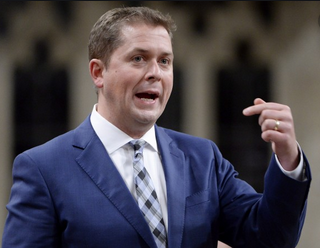 The country doesn’t know this man all hat well. This election campaign is making him much more visible to people of every political persuasion. Scheer’s recently unveiled environment plan, which he labels as the best climate action plan, has been estimated to actually increase rather than reduce emissions by 2030, Canada’s target year under the Paris climate agreement. While there is independent analysis which shows the Liberal plan is likely to miss the 2030 target, it will at least reduce emissions.
Mr. Scheer’s claim made in the same breath that he attacks Mr. Trudeau, for likely missing the target, is more than duplicitous – a case of ‘talking rather than walking’, and following the lead of Tory provincial governments in Alberta and Ontario. Mr. Ford, for example, is increasing speed limits on its multi-lane highways which will lead to increased fuel use and auto emissions of at least 10%.
 The Bloc is still a strong political force in Quebec. There is no social acceptability for an oil pipeline in Quebec, so Mr.Scheer won’t find any support among the separatist Bloc Quebecois, the provincial-only federal political party which is rising in the polls again in Quebec. Bloc policies for the most part are similar to those of the NDP, without a lot of the separatist rhetoric.
But even on separatism, it is no secret that Quebecers switched their votes en mass from the Bloc to the NDP once Jack Layton defied the Supreme Court and promised Quebecers, were he the prime minster, they could separate on a vote of 51%. And Jagmeet Singh has learned well from the master, stirring the pot with fresh foolish promises for a new federal deal and a more independent Quebec.
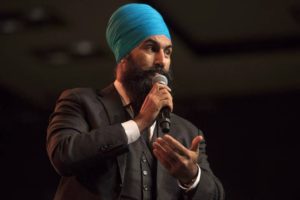 Jagmeet Singh doesn’t have a lot of room for any political maneuvering. Singh, in the short time he has been leader of the NDP, has proven every bit as opportunistic as Layton was. He is talking out of both sides of his mouth on TMX and the B.C. LNG project, approved and subsidized by both the feds and the province. Still, both he and Green Party leader Elizabeth May would have a membership revolt were they to support Scheer’s plans.
 Green Party leader Elizabeth could end of holding the balance of power. And without that support Scheer would have to go it alone, hoping the Liberals would support him on some issues. But Scheer has been particularly nasty when it comes to Mr. Trudeau, even in the pre-campaign period, so if there is some support it won’t be out of love. Scheer would need to try a little tenderness when it comes to his main opponent.
 If you live in Alberta – this pipeline is the path to prosperity. One Alberta news media is pleading for a majority government by either main party, amid the fear that the TMX pipeline may be cancelled as a ransom demand by third parties in a minority government. The parties on the right can count on about a third of the all the votes, another third will likely go to the Liberals and the remainder will be held by the smaller left leaning parties.
The stronger the support for the third parties, the greater the chance that Mr. Scheer will able to slip up the middle and win a majority government, much as Ontario premier Doug Ford did last year. But the reality is that unless Andrew Scheer breaks through the 170 seat barrier he might as well trash most of his party’s platform. He will not be able to implement it in whole, nor even most of its components. Trying to do that would doom him to the fate suffered by Joe Clark – a short lived term in office followed by another election.
 Ray Rivers writes regularly on both federal and provincial politics, applying his more than 25 years as a federal bureaucrat to his thinking. Rivers was once a candidate for provincial office in Burlington. He was the founder of the Burlington citizen committee on sustainability at a time when climate warming was a hotly debated subject. Ray has a post graduate degree in economics that he earned at the University of Ottawa. Tweet @rayzrivers Ray Rivers writes regularly on both federal and provincial politics, applying his more than 25 years as a federal bureaucrat to his thinking. Rivers was once a candidate for provincial office in Burlington. He was the founder of the Burlington citizen committee on sustainability at a time when climate warming was a hotly debated subject. Ray has a post graduate degree in economics that he earned at the University of Ottawa. Tweet @rayzrivers
Background links:
Election Tipping Points – Political Coalition –
Maxime Bernier –

 By Pepper Parr By Pepper Parr
September 30th, 2019
BURLINGTON, ON
 The view of the as yet unnamed tower as you drive into Burlington from the east. Mayor Marianne Meed Ward left the meeting before it ended. A presentation was being made by Old Lakeshore Burlington Inc. who were explaining what their development proposal idea was for the property at the east end of where Old Lakeshore Road and Lakeshore Road was going to look like; she had heard all she needed.
A part of the city that she used as the rallying cry for her election to city council in 2010 was about to be turned into something similar to what Toronto did to the land south of the Gardner Expressway and Lake Ontario. It was not what she had in mind for her city.
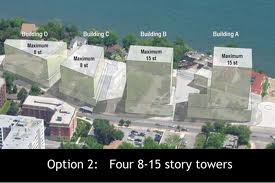 This was the limit Marianne Meed Ward was calling for in the 2010 election. The provincial government approach to development changed when Doug Ford came into office, the massive change in what LPAT (Local Planning Authority Tribunal) was going to do for the municipal sector wasn’t helping.
Was there a way out of or around what was heading our way?
There might be.
At this risk of using a phrase that didn’t actually resonate in Burlington – it is time to be bold. Let’s try – “Daring to be a Daniel” instead.
There is in the municipal world a number of tools that can be put to very good use – but it does require some creativity.
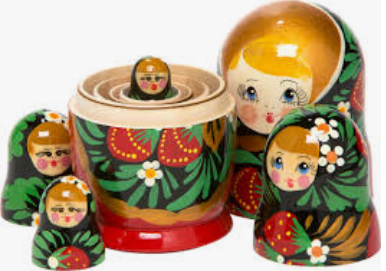 A doll within a doll – a planning tool within a planning tool. I spoke to a number of people about what the city is up against and got some solid feedback. One resident, long in the tooth and the holder of much wisdom and experience in matters related to planning, suggested the approach the city could take is a little like those Russian nesting dolls.
All these planning and land management tools can be made to fit into each. It takes very tight strategic thinking and you’re going to need a lot of that high priced legal talent to make it all happen – but they experts we spoke to told us it could perhaps be done.
Is it worth the risk to take a shot at it?
 The developer sees the 26 storey tower as the eastern gateway to the city – it’s impressive. Is it the best thing for the city? There is currently an Interim Control Bylaw in place for the Urban Growth Centre. It has about eight months left in the first year it is going to be in place. The city could extend that bylaw for a second year.
The Chief Planner Heather MacDonald has a team of consultants working with her on what the city might do in terms of the kinds of development that will be permissible.
 The A and B properties are in what is called the “football” The “football” is within that Urban Growth boundary – so nothing is going very far until that interim bylaw is lifted.
What I learned in my talks with a number of people is this:
The review of the adopted – but not yet passed by city council Official Plan, could designate certain lands as having a special interest for the city in terms of the long range development.
They could put what is known as an H designation – a HOLD on what gets done with a piece of property.
With that hold in place the city has time to re-think where it wants to go.
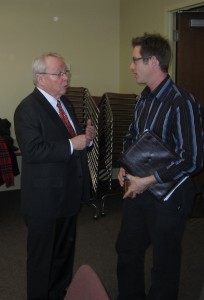 Former Toronto Mayor David Crombie talking to Mike xxx, who at the time was President of the Save our Waterfront group that had 1000 members, With that time available Burlington can then form a group that studies the potential for the “football”; former Mayor David Crombie suggested to the Waterfront Advisory Committee that was in place at the time that they do just that. He added that putting a couple of “oddballs” on such a committee is always a good idea.
I learned that there is also a Community Improvement section in the Municipal Act – it is sometimes referred to as a Community Development Plan.
That part of the Act could be used to put together a plan that had wide wide stakeholder involvement. These plans, I was told, give a municipality a tremendous amount of power and scope – they are in effect putting the needs and interests of the citizens first.
Right now the Planning department is dealing with a development application, which they have to accept and issue a report on. They don’t have anything to compare it to – something that might be better for the city.
If the buy in from the public was high enough the city could move to expropriate all the land within the “football” and float a bond to pay for it.
If the Mayor wanted to get really creative she could look for a way to create a bond that the average citizen could units of.
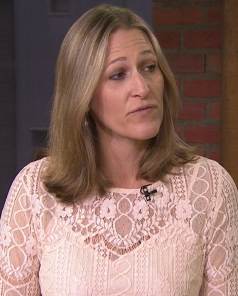 Does the Mayor think there is a way out of what the developers have told us they want to do with the football? Will the Mayor manage to toss it back to them and expropriate the land. Meed Ward is staring at a couple of developments that will put 26 storey condominiums on land she believes should not be any higher than 12 storeys.
LPAT will not let that happen – the developers know they will win at that level.
There just might be a way to do something truly stunning for the city.
 All of this was close to given away to the owners of properties that abutted the waterfront. That terrible loss the city suffered when lake front land between Market and St. Paul was sold for a pittance can’t be reversed – but amends could be made for that loss.
Emma’s Back Porch and the Water Street Cookery could be part of something truly unique.
All it takes is takes innovation, creativity and courage.
We are far from experts in this field. But we do believe that citizens will stand up for themselves when the leadership they want leads.
The 2006, 2010 and the 2014 city council’s didn’t lead. Mayor Meed Ward has made it clear things will be done differently – how much differently.
Let’s see where the Gazette’s active comment people have to say.
Salt with Pepper is the musings, reflections and opinions of the publisher of the Burlington Gazette, an online newspaper that was formed in 2010 and is a member of the National Newsmedia Council.

 By Pepper Parr By Pepper Parr
September 26th, 2019
BURLINGTON, ON
There is a meeting taking place this evening at the Central Arena, on Drury Lane road, across the street from the YMCA.
 The public will get a look at what the developer wants to do with the southern end of the “football” the land between Lakeshore Road and Old Lakeshore Road. It is a pre-consultation meeting, a non-statutory meeting to obtain community input on all of these elements prior to the submission of an application. Planning staff will be in attendance to provide information on the development application review process and next steps. The owner and consultant team representatives will also be in attendance to listen and collect ideas and input from the community.
Old Lakeshore Burlington Inc. is the owner of lands located at 2107-2119 Old Lakeshore Road. The City’s current policies provide for the potential development of a tall building of up to 12 storeys on these lands. The owner is currently considering the redevelopment of the lands with a mixed-use tall building of up to 26 storeys.
This is the way development takes place in Burlington.
 The properties the CORE development group want to put 26 storeys on. A number of months ago there was another such pre-consultation public meeting. This one was at the Art Gallery. It went through the same process; there weren’t a lot of people in that room with much in the way of appetite for the development. The developer in that case was the CORE group.
When the Gazette asked for a copy of the presentation made by the developer – they promised to send it along the next day, we are still waiting for that one.
 A 3D model of what the south eastern core of the city would look like if the CORE development on the table is approved and built. Another developer wants to build a high rise at the eastern end of the Lakeshore and Old Lakeshore intersection. Both developments, the CORE development and the Old Lakeshore Burlington development, are in the same part of town – what is sometimes referred to as the “football” – referring to the shape of the property that exists between Old Lakeshore Road and Lakeshore Road.
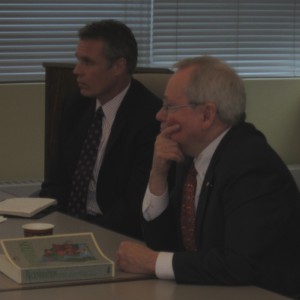 Former Mayor Rick Goldring sits beside former Toronto Mayor David Crombie to listen to members of the Waterfront Advisory Committee. A number of years ago, when there was a Waterfront Advisory Committee chaired then by Nick Leblovic they invited former Toronto Mayor David Crombie to talk to them about how development can be managed so that the wishes and the will of the public are at least heard. Crombie at the time said: You need to put together a committee and ensure that you have a couple of oddballs at the table – they are the people that pop out the interesting ideas.
Then Mayor Goldring sat in on that meeting; nothing ever came of the idea. Sometime later the Waterfront Advisory was put to rest.
Any development ideas were going to come from the development community. And that is what we are looking at today.
The very significant sized developments that abut each other on what is now the most valuable developed land near the lake, across from Emma’s Back Porch and a football field length away from the Bridgewater development which appears stalled.
There is no public protesting; there is no group formed to suggest that this is not the way this part of the city should be developed.
Other than saying the city doesn’t want this type of growth in this part of the city Mayor Meed Ward hasn’t said very much.
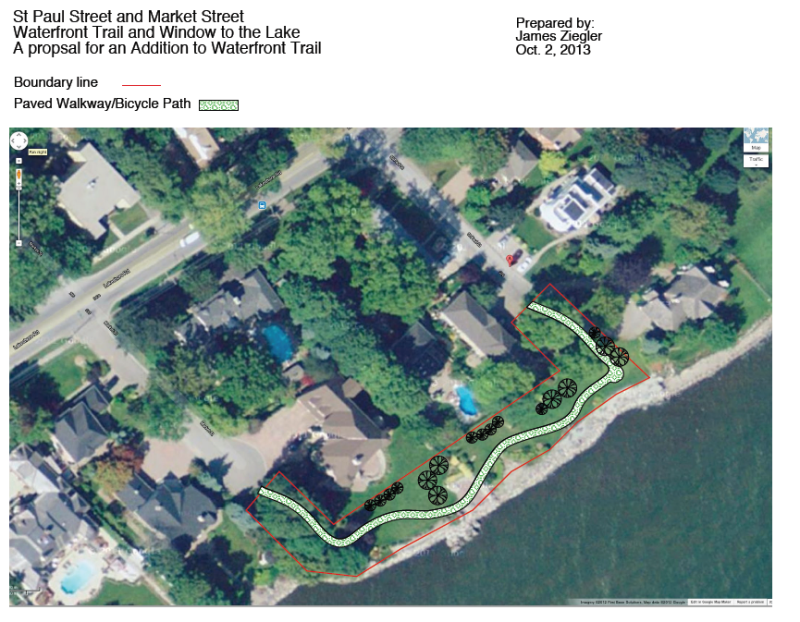 All the land within the red outline was public. The city went along with the sale of the pieces in the middle that abutted houses – they kept the piece of land at each end and turned them into Windows on the Lake. A Crown Jewel had been sold. Burlington lost the opportunity to keep a large part of the waterfront in public hands when it went along with the sale of that land between Market and St. Paul.
Meed Ward, as a Councillor fought a valiant battle to maintain ownership of that property – despite her efforts then, Crown Jewels were sold for a pittance and the province got most of the money.
George Santayana, a noted philosopher, essayist, poet, and novelist who once appeared on the cover of Time magazine wrote that: “Those who cannot remember the past are condemned to repeat it.”
It is going to take a lot more than people who attend the meeting this evening saying this is not what the city wants – it is going to take real leadership – not from just the Mayor but from every member of council.
 This is the crowd that is going to have to step up, get creative, be bold and find a better way to develop the land in the “football”. Time for the newbies to step up to the plate – let’s see what you are made of.
Salt with Pepper is the musings, reflections and opinions of the publisher of the Burlington Gazette, an online newspaper that was formed in 2010 and is a member of the National Newsmedia Council

 By Ray Rivers By Ray Rivers
September 26th, 2019
BURLINGTON, ON
“But if you can look past the anecdotal evidence — a hard feat for everyone, no doubt — you’ll find an economy performing pretty well. And in a world full of turmoil and trouble, pretty well is pretty good.” (Peter Armstrong, Senior Business Reporter CBC)
The folks that gave us Doug Ford are at it again. Like the fabled Don Quixote thrusting his lance at imaginary enemies, we hear the NDP and Conservatives complaining about the lack of economic progress over the last four years.
The facts are:
1. Gross disposable personal income in Canada reached an all time high this year;
2. Inflation is almost negligible mainly hovering at less than 2%;
3. Unemployment is at a four decade low;
4. The median after-tax income for 2017, $59,800, was the highest in Canadian history;
5. The number of millionaires continues to grow; and
6. Almost 900,000 Canadians were lifted beyond the poverty line between 2015 and 2017, the greatest ever reduction of poverty in the country’s history.
This last statistic is most noteworthy as the Liberal government exceeded its own goal of reducing poverty by 20% by 2020. This reduced the percentage of people living below the poverty line to less than 10% for the first time in our country’s history. 52,000 single seniors were brought out of poverty.
This was a remarkable feat given that the economy had been teetering on recession when Trudeau took over as P.M. Increasing the progressiveness of our income tax system and choosing to invest in both structural and social programs has paid off. Canada’s economy, despite some trade challenges, such as US steel and aluminum tariffs, uncertainty over a new NAFTA, the continued depression of oil prices, and China’s banning meat and soybean imports, has continued to propel forward.
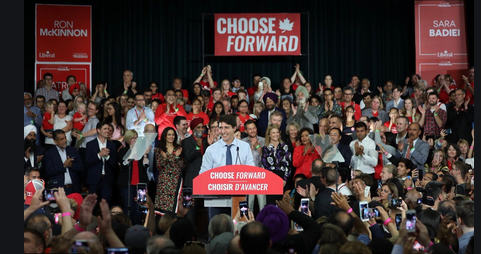 The public loved the name, they loved the image and he campaigned very well. The question now is: did he deliver on the promise and what are the options for voters. Much of this growth was accomplished only because our government borrowed money to finance its programs rather than levy new taxes or do nothing at all. Canada’s deficits have become the tools which allowed us to achieve our economic progress. But, of course, Mr. Trudeau’s 2015 election promise of eliminating the deficit by this year is unrealized- lost in the inevitable trade off.
And yet despite large deficits, not only has the economy progressed but the economic significance of the deficits has diminished. Canada’s total debt as a percentage of its gross domestic product has been declining. And that, for anyone who understands debt financing in business, is the most important metric. Our economic growth more than pays for the debt financing.
 The country had tired of Harper and didn’t believe that Mulcair could run, never mind form a government. It was an unusual campaign promise last election. Contrasted with the NDP and Tory promises of balanced budgets, Mr.Trudeau argued that, given this period of low interest rates, now was the time to invest in Canada’s economy and enhancing its structural and social infrastructure – building for the future while money is still cheap.
And clearly it worked, propelling the country which had been teetering on recession during the last Harper year, to a pathway of solid growth and prosperity. In the end this has been a truly enviable record of economic achievement. Also, since most of the money borrowed is from Canadians, we are reasonably insulated from the vagaries of international currency manipulation.
But despite the best political wisdom, a restored and booming economy won’t ensure a government’s re-election. Otherwise how does one explain what happened in Ontario in 2018?
The opposition PCs made the election about hydro rates and the deficit, detracting from the province’s economic recovery and virtual boom.
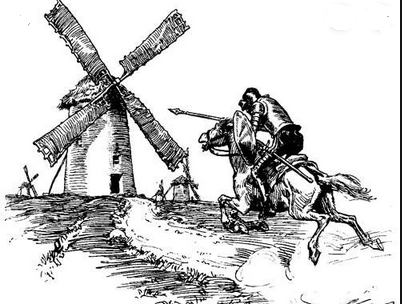 Don Quixote thrusting his lance at imaginary enemies. Mr. Ford inflated his estimated deficit numbers to scare the public into thinking the bailiff was at the door. It is the same bogey man Mr. Scheer is using in the federal election, although like Mr. Ford, he has no intention of deficit elimination. And as for hydro rates – it’s just another broken promise.
But just like Cervantes’ anti-hero these hapless politicians are also tilting at windmills – pointing at problems which don’t really exist.
 Ray Rivers writes regularly on both federal and provincial politics, applying his more than 25 years as a federal bureaucrat to his thinking. Rivers was once a candidate for provincial office in Burlington. He was the founder of the Burlington citizen committee on sustainability at a time when climate warming was a hotly debated subject. Ray has a post graduate degree in economics that he earned at the University of Ottawa. Tweet @rayzrivers Ray Rivers writes regularly on both federal and provincial politics, applying his more than 25 years as a federal bureaucrat to his thinking. Rivers was once a candidate for provincial office in Burlington. He was the founder of the Burlington citizen committee on sustainability at a time when climate warming was a hotly debated subject. Ray has a post graduate degree in economics that he earned at the University of Ottawa. Tweet @rayzrivers
Background links:
Don Quixote – Millionaires – Lowest Poverty Rate –
Social Development – Cost of Living – Disposable Income –
Labour Productivity –

|
|


 This ongoing innovation is increasing the complexity of purchasing decisions and farmers are often wondering whether the value is really there. Not to mention, many of these technologies are often too expensive, especially for farmers who own small to medium sized farms. In addition, many farmers find they do not get the full value from these technologies as they often only utilize a small portion of the functionality that the solution is capable of.
This ongoing innovation is increasing the complexity of purchasing decisions and farmers are often wondering whether the value is really there. Not to mention, many of these technologies are often too expensive, especially for farmers who own small to medium sized farms. In addition, many farmers find they do not get the full value from these technologies as they often only utilize a small portion of the functionality that the solution is capable of.
































































































